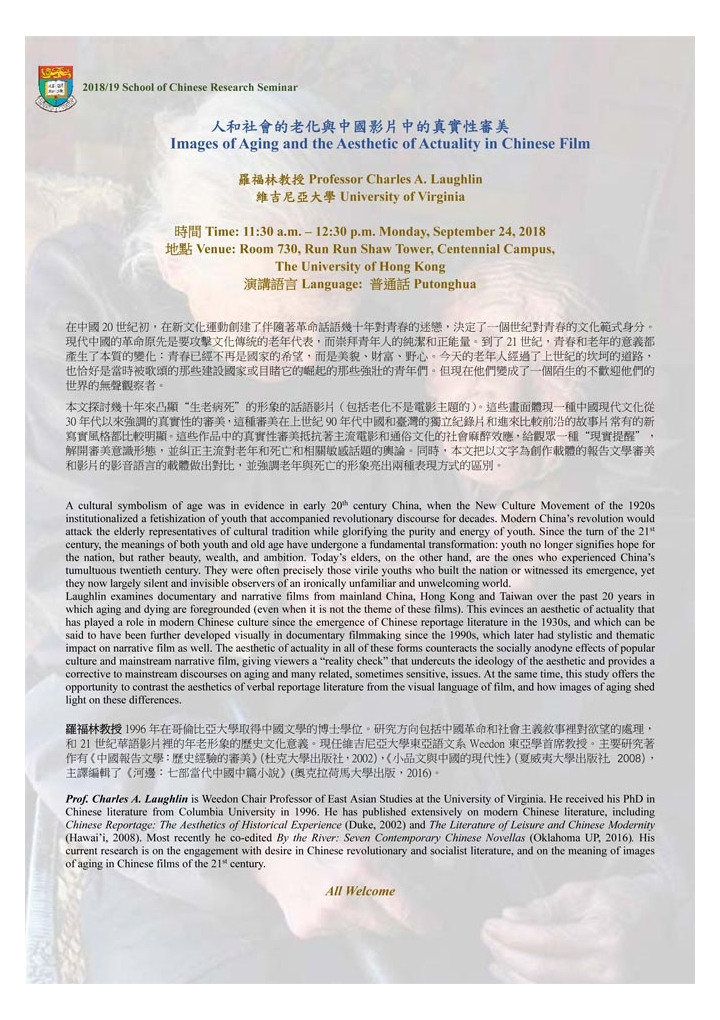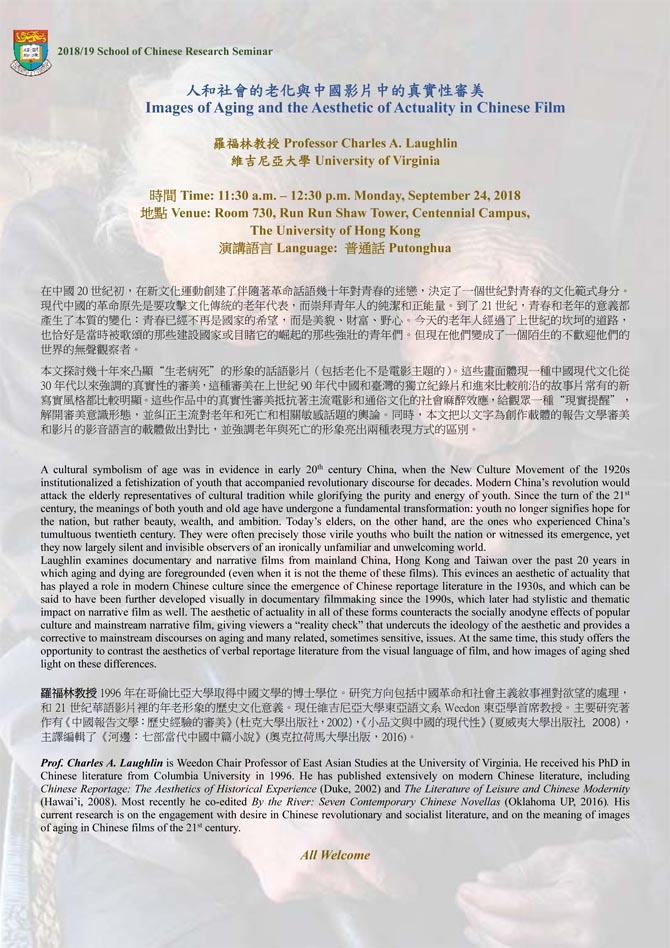人和社會的老化與中國影片中的真實性審美

2018/19 School of Chinese Research Seminar
人和社會的老化與中國影片中的真實性審美
Images of Aging and the Aesthetic of Actuality in Chinese Film
羅福林教授Professor Charles A. Laughlin
維吉尼亞大學University of Virginia
時間Time: 11:30 a.m. – 12:30 p.m. Monday, September 24, 2018
地點Venue: Room 730, Run Run Shaw Tower, Centennial Campus,
The University of Hong Kong
演講語言Language: 普通話Putonghua
在中國20世紀初,在新文化運動創建了伴隨著革命話語幾十年對青春的迷戀,決定了一個世紀對青春的文化範式身分。現代中國的革命原先是要攻擊文化傳統的老年代表,而崇拜青年人的純潔和正能量。到了21世紀,青春和老年的意義都產生了本質的變化:青春已經不再是國家的希望,而是美貌、財富、野心。今天的老年人經過了上世紀的坎坷的道路,也恰好是當時被歌頌的那些建設國家或目睹它的崛起的那些強壯的青年們。但現在他們變成了一個陌生的不歡迎他們的世界的無聲觀察者。
本文探討幾十年來凸顯“生老病死”的形象的話語影片(包括老化不是電影主題的)。這些畫面體現一種中國現代文化從30年代以來強調的真實性的審美,這種審美在上世紀90年代中國和臺灣的獨立紀錄片和進來比較前沿的故事片常有的新寫實風格都比較明顯。這些作品中的真實性審美抵抗著主流電影和通俗文化的社會麻醉效應,給觀眾一種“現實提醒”,解開審美意識形態,並糾正主流對老年和死亡和相關敏感話題的輿論。同時,本文把以文字為創作載體的報告文學審美和影片的影音語言的載體做出對比,並強調老年與死亡的形象亮出兩種表現方式的區別。
A cultural symbolism of age was in evidence in early 20th century China, when the New Culture Movement of the 1920s institutionalized a fetishization of youth that accompanied revolutionary discourse for decades. Modern China’s revolution would attack the elderly representatives of cultural tradition while glorifying the purity and energy of youth. Since the turn of the 21st century, the meanings of both youth and old age have undergone a fundamental transformation: youth no longer signifies hope for the nation, but rather beauty, wealth, and ambition. Today’s elders, on the other hand, are the ones who experienced China’s tumultuous twentieth century. They were often precisely those virile youths who built the nation or witnessed its emergence, yet they now largely silent and invisible observers of an ironically unfamiliar and unwelcoming world.
Laughlin examines documentary and narrative films from mainland China, Hong Kong and Taiwan over the past 20 years in which aging and dying are foregrounded (even when it is not the theme of these films). This evinces an aesthetic of actuality that has played a role in modern Chinese culture since the emergence of Chinese reportage literature in the 1930s, and which can be said to have been further developed visually in documentary filmmaking since the 1990s, which later had stylistic and thematic impact on narrative film as well. The aesthetic of actuality in all of these forms counteracts the socially anodyne effects of popular culture and mainstream narrative film, giving viewers a “reality check” that undercuts the ideology of the aesthetic and provides a corrective to mainstream discourses on aging and many related, sometimes sensitive, issues. At the same time, this study offers the opportunity to contrast the aesthetics of verbal reportage literature from the visual language of film, and how images of aging shed light on these differences.
羅福林教授1996年在哥倫比亞大學取得中國文學的博士學位。研究方向包括中國革命和社會主義敘事裡對欲望的處理,和21世紀華語影片裡的年老形象的歷史文化意義。現任維吉尼亞大學東亞語文系Weedon東亞學首席教授。主要研究著作有《中國報告文學:歷史經驗的審美》(杜克大學出版社,2002),《小品文與中國的現代性》(夏威夷大學出版社,2008),主譯編輯了《河邊:七部當代中國中篇小說》(奧克拉荷馬大學出版,2016)。
Prof. Charles A. Laughlin is Weedon Chair Professor of East Asian Studies at the University of Virginia. He received his PhD in Chinese literature from Columbia University in 1996. He has published extensively on modern Chinese literature, including Chinese Reportage: The Aesthetics of Historical Experience (Duke, 2002) and The Literature of Leisure and Chinese Modernity (Hawai’i, 2008). Most recently he co-edited By the River: Seven Contemporary Chinese Novellas (Oklahoma UP, 2016). His current research is on the engagement with desire in Chinese revolutionary and socialist literature, and on the meaning of images of aging in Chinese films of the 21st century.
All Welcome









